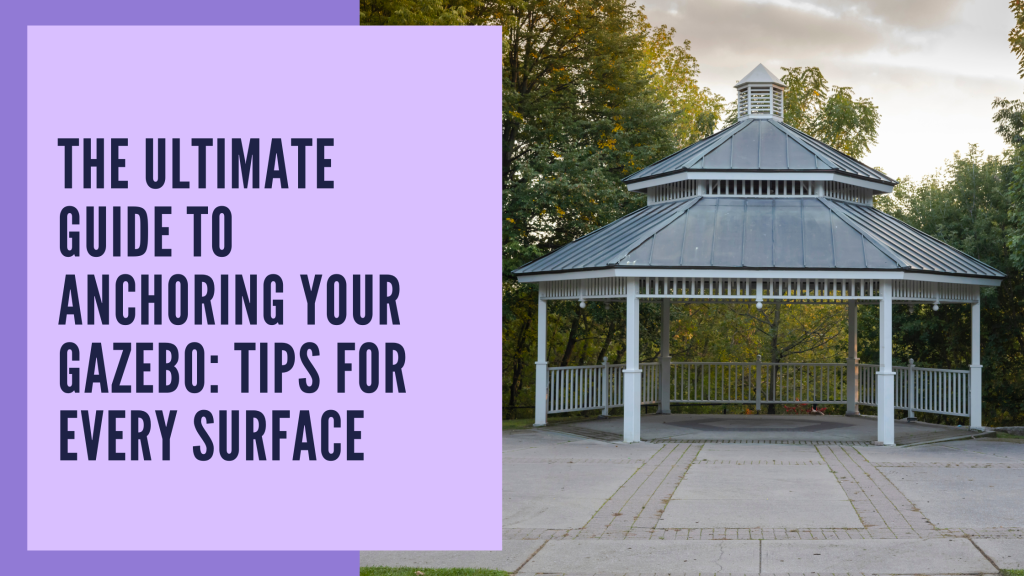A gazebo is a wonderful addition to any backyard, offering a sheltered space for relaxation, entertainment, and enjoying the outdoors. However, ensuring that your gazebo stays in place is just as important as setting it up. Gazebo anchoring is crucial for safety and longevity, especially when faced with windy conditions or heavy use. This comprehensive guide will walk you through the different methods of anchoring your gazebo to various surfaces, including concrete, pavers, and more. Whether you’re working with a gazebo on a concrete slab, a grassy area, or a patio, we’ve got you covered.
Understanding the Basics of Gazebo Anchoring
Importance of Stability and Safety
Proper gazebo anchoring ensures that your structure remains stable and secure, even during strong winds or storms. A poorly anchored gazebo can collapse, causing damage to the structure or harm to people in the area. Anchoring your gazebo protects your investment and guarantees it remains standing for years to come.
Key Tools and Materials
To anchor a gazebo securely, you’ll need the right tools. Common materials include anchors, screws, bolts, and weights. Depending on your surface, you may also need drills for concrete or stakes for soil. Before starting, make sure you have everything you need, and check whether any additional hardware like brackets or reinforcement crossbeams will be necessary.
Factors to Consider Before Anchoring
Before you get started with the anchoring process, there are a few factors to keep in mind:
- The type of surface where you plan to place your gazebo (grass, concrete, pavers, etc.).
- The weather conditions in your area, especially wind levels.
- The type of gazebo (permanent, semi-permanent, or temporary).
- Whether you’re using a metal gazebo, wooden structure, or other materials.
Anchoring on Grass or Soil
Using Ground Stakes
For anchoring a gazebo to the ground on soft surfaces like grass or soil, ground stakes are a popular option. Simply insert the stakes into the ground at each corner of the gazebo, and then secure them tightly to hold the structure in place. This method is simple but effective for securing the gazebo without permanent installation.
Auger Anchors for Enhanced Stability
For better stability, consider using auger anchors. These anchors have a spiral shape, which helps them dig deep into the ground and provide stronger resistance against wind and shifting. Auger anchors are perfect for areas with softer soil.
Preventing Shifting in Soft or Wet Soil
In areas where the soil is prone to becoming soft or wet, consider reinforcing your anchors. Using a combination of auger anchors and ground stakes will help prevent shifting. Additionally, consider placing the gazebo on a solid base, such as gravel, to enhance its stability.
Anchoring on Concrete
Drilling and Bolting
One of the most reliable methods for anchoring a gazebo to concrete is through drilling and bolting. Use a concrete drill bit to create holes at the corners of your gazebo’s frame, and then insert bolts to secure it firmly in place. This method is perfect for a gazebo on concrete slab or gazebo concrete floor setups.
Weighted Anchors
Another option for securing a gazebo on concrete without drilling is to use weighted anchors. These can be large sandbags or other heavy objects placed around the base of the gazebo to keep it anchored down. While less permanent, weighted anchors are ideal if you don’t want to make holes in the concrete.
Adhesive Anchors for Semi-Permanent Solutions
If drilling is not an option, adhesive anchors offer a semi-permanent solution. These anchors use strong industrial adhesives to bond the base of your gazebo to the concrete. While not as secure as bolts, they are perfect for those who want a less invasive method of attachment, especially if the gazebo is not intended for long-term use.
Anchoring on Wooden Decks
Using Lag Bolts or Screws
When installing a gazebo on a wooden deck, you can anchor a gazebo to the ground by using lag bolts or screws. These are driven into the deck’s frame and are effective at holding the gazebo in place, even in windy conditions.
Adding Reinforcement with Crossbeams
For extra security, add reinforcement by attaching crossbeams to the structure. This will create additional points of attachment, making the gazebo more secure and less likely to shift or sway.
Using Non-Invasive Weighted Solutions
If you don’t want to drill into your deck, you can use non-invasive weighted solutions, such as large planters filled with rocks or sand. Placing these around the base of your gazebo will help hold it down without causing any damage to your deck.
Anchoring on Paved Surfaces
Using Weighted Anchors
For gazebo on pavers, weighted anchors are one of the most effective solutions. Simply place heavy objects around the gazebo’s base to secure it in place. This method works best for temporary setups, where you want to avoid drilling into the pavers.
Portable Base Plates
Another option for securing a gazebo on paved surfaces is to use portable base plates. These base plates are heavy and can be moved around, but they provide excellent stability for gazebos placed on pavers.
Drilling and Installing Anchors
If you want a more permanent solution, drilling and installing anchors is a viable method. This involves drilling holes into the pavers and placing anchors into them to secure the structure.
Anchoring for Temporary Gazebos
Pop-Up Gazebos for Events
Temporary pop-up gazebos often need quick anchoring to ensure they don’t blow away in the wind. Use portable weights or sandbags to anchor the structure, and be prepared to adjust them based on changing weather conditions.
Portable Weights for Quick Assembly
For events or temporary uses, portable weights are perfect for securing a gazebo from wind quickly. They are easy to carry and set up and can be placed around the legs of the gazebo to ensure it stays in place.
Adjusting Anchors Based on Weather Conditions
When anchoring temporary gazebos, adjust the weights and anchors based on the weather. In windy conditions, you may need additional sandbags or heavier weights to keep the gazebo stable.
Tips for Choosing the Right Anchoring Solution
- Consider your surface type. Different surfaces require different anchoring methods.
- Think about whether you need a permanent or temporary solution.
- Always check the weather forecast before setting up a gazebo.
- Choose a method that’s easy to maintain and adjust if necessary.
- Don’t forget about safety; secure the gazebo to prevent accidents.
Common Mistakes to Avoid
- Not using enough anchors: It’s important to ensure that your gazebo is secured with sufficient anchors, especially in high winds.
- Not adjusting for wind conditions: If you live in a windy area, you may need to adjust your anchoring solution periodically.
Ignoring surface type: Different surfaces need different types of anchors – make sure you choose the right one for your setup.







